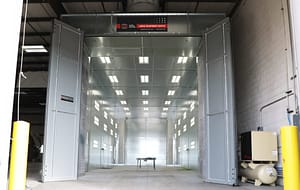GFS’ direct, gas-fired Air Make-Up Units (AMUs) provide an economical source of replacement air and are furnished with a heater, filters, motor and blower, controls, mounting hardware, and auxiliary equipment.
GFS AMUs use structural G90 galvanized steel for the base and tube frame, along with heavy-duty G90 steel casing. Additional construction features include:
| Interlocked wall seam and roof panels |
| Weatherproof construction |
| Hinged service doors with flush-mount latches |
| Casing insulation with G90 galvanized steel liners |
Multiple mounting arrangements:
|
During Spray Booth Operations:
A spray booth’s exhaust system removes significant quantities of shop or plant air. A typical-sized paint booth may exhaust more than 8,000 CFM. If replacement air is pulled directly from outside, this volume may be sufficient to cool the interior of the building, adversely affecting the quality of coatings. An air make-up unit, which supplies conditioned and filtered air to the booth, may be required to minimize temperature variations and remove particles that compromise finish quality.
In the case of pressurized paint booths, air replacement is introduced directly into the booth, eliminating the need for air to be drawn from the facility. This allows for greater control over the temperature and filtration quality in both the facility and the spray booth environment, therefore improving working conditions and lowering overall operating costs.
The constant volume system provides a consistent rate of supply air to the facility. The direct-fired air system heater warms the fresh air on intake, eliminating energy losses associated with alternative heat sources.
In most applications, the intake air is of slightly higher volume than the exhausted air, resulting in a positive building pressure for best results. However, these units can be adjusted to intake less volume than the exhaust for applications requiring a negative building pressure.
When air replacement requirements fluctuate and constant-volume or two-speed systems are not suitable, a variable air volume system is the solution. By integrating a variable frequency drive (VFD) into the motor system, automatic adjustments can be made to the system during operation to compensate for changing conditions. Several options are available to control these adjustments:
The VFD allows for much lower energy costs due to smooth motor start-up and the elimination of power spikes. Integrated safety features have been added to ensure safe burner operation.
For operations requiring recirculating capability, an 80/20 system can provide energy-efficient make-up air and heating functions. By drawing at least 20 percent outside air and up to 80 percent recirculated air from the building, the 80/20 system reduces the energy needed for heating. The ratio of new-to-recirculated air varies according to the requirements of the building environment.
Automatic sensors and pressure monitors continually adjust to maintain the most consistent working environment, the most efficient operation and the lowest operating cost. These units can be configured as a fully-functional building heat unit, a supplementary air make-up or a combination of both.
In variable speed and recirculating units, the AMU is designed to discharge 140-degree or 160-degree Fahrenheit air for an accelerated curing cycle. These systems also include an auto-balance system with a variable frequency drive (VFD) to automatically adjust the airflow of the exhaust fan(s) and ensure proper booth balance, not only during cure mode but also during paint mode.
The variable-speed unit always uses outside air while curing to ensure good, clean air for the cure cycle. This design reduces airflow by 50 percent during cure mode.
This design recirculates up to 80 percent of the air while exhausting 20 percent to the atmosphere, providing further energy efficiency through the recirculation of heated air, requiring less for the heating unit.
| Accessories & Options: | Unit Location Considerations: |
| Inlet hood with 2-inch, cleanable filter with bird screen | Fresh air intake vs. shop air intake |
| Fresh air V-Bank filter sections | Unit size and arrangement |
| Return air V-Bank filter sections | Proximity of the AMU air discharge to the spray booth |
| External/Internal discharge dampers | Access for installation and service |
| Intake dampers | Heat type |
| Air diffuser heads | Discharge type |
| Vertical mounting stand (enclosed and open) | |
| Roof curbs | |
| Casing insulation with G90 galvanized steel liners | |
| Control panel with operating lights | |
| Spring isolated blower and motor | |
| Painted casing |
GFS products are designed and manufactured to meet the applicable requirements of various industry-recognized codes and standards.
Please be aware that local requirements may vary from national codes. GFS recommends consulting with your local authority before purchasing paint booths or other finishing equipment.
GFS engineers regularly contribute to the advancement of codes and standards that affect the industries that we work in. Several of our engineers serve on various NFPA Technical Committees responsible for key finishing industry standards.

Air make-up units replace contaminated air exhausted from industrial and commercial buildings or spray booths, with heated outdoor air. AMUs maintain a constant leaving-air temperature regardless of the incoming, outdoor air temperature. Air make-up units replenish equal amounts of fresh air for every cubic foot of air exhausted.
A direct-fired burner with a turndown ratio of 30:1 is 100 percent efficient — all the heat goes directly into the airstream. The high turndown capability allows the flame to adjust to outdoor air temperature swings throughout heating season. For example, a unit with a maximum temperature rise of 90 degrees in the winter can adjust down to as little as a 3-degree temperature rise for milder spring and fall weather.
Temperature Swings
Exhausted Air
Let us know your product requirements, and we will put you in touch with a distributor in your area.

Not a Small World: Large Equipment Paint Booth Has Camping World of Madison Thinking Big

6 Pieces of Finishing Equipment for Sustainable Environmental Growth

Top 5 Blog Posts of 2021